The Mechanics Of A Breaking Pitch
Does a curveball really curve, or is it just an illusion? Finally, the definitive answer.
BY JIM KAAT
Published on: April 1, 1997
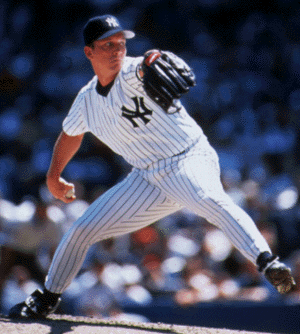
It is Game 3 of the 1996 World Series. The Atlanta Braves have already taken the first two games in the Bronx. If they can beat the Yankees here in Fulton County Stadium, in Atlanta, they'll hold a seemingly insurmountable 3-0 lead in the Series and the Yankees can hang it up until next year.
But things have gone the Yankees' way in this game. A courageous effort by starting pitcher David Cone and excellent support by relievers Mariano Rivera and Graeme Lloyd have kept the Braves' big bats in check, and going into the bottom of the ninth, it's 5-2 Yankees as ace reliever John Wetteland takes the mound to close it out.
Wetteland is known for his blazing 99-mph fastball, and there is no reason for first batter Javier Lopez to look for anything else. Sure enough, Wetteland feeds Lopez nothing but heat and Lopez has all to do to ground feebly to Derek Jeter at short. But in his haste to make the play, Jeter bobbles the ball and Lopez is on.
Andrew Jones comes up. Jones, a rookie, has fed on Yankee pitching the first two games of the Series, including a couple of homers. A home run here and Atlanta is within one.
Wetteland bears down and brings heat. Jones looks at fastball after fastball, managing to foul a couple off and take a couple for balls. With the count two and two, Jones gears for yet another fastball as Wetteland comes set and checks the runner. At almost 100 mph, Wetteland's fastball reaches home plate in less than a second. Jones will have to start his swing before Wetteland actually releases the ball if he is to have any hope whatsoever of hitting it.
Wetteland deals. Jones starts his bat and begins to stride. The ball is released. But wait. Jones recognizes the spin on the ball. He sees the stitches. Oh no. Not a fastball. A breaking ball. Jones holds back his swing. His front leg has started to move. He holds back mightily. His left knee visibly buckles but he holds back. He can't pull the trigger. His only hope is that the pitch will be called a ball.
"Steeeeh!" screams plate umpire Tim Welke and Jones is out of there looking.
Strike three.
Such is the power of the unexpected breaking pitch in baseball, especially when a power pitcher like John Wetteland sets it up with one fastball after another. In fact, in this game the next batter, Jeff Blauser, strikes out on three straight fastballs and pinch-hitter Terry Pendleton grounds weakly to second to end the game. Knowing that Wetteland can throw a breaking ball at any moment is a weapon in itself. It throws off the batter's timing and prevents a hitter from merely sitting on a pitcher's fastball.
Supervision Settles It
Pitchers, batters and catchers have always known that a breaking ball actually moves-that is, curves or sinks. But skeptics have maintained that the breaking ball is some kind of illusion. Supervision has settled the matter once and for all.
A 90-mph fastball takes four-tenths of a second to reach home plate. Supervision captures images of the pitch from 16 different locations in 3-dimensional positions using stadium-mounted cameras, computers, special-effects generators and trigonometric triangulation. The system can replay a graphic trajectory of the pitch within 1 second after the ball hits the catcher's mitt. It shows the ball's actual path of travel from mound to plate and breaking movement of the ball inside the strike zone.
It's a view batters wish that they could see before the pitch is thrown.
–Cliff Gromer

Animation of ball trajectory from mound to home plate, while shadow of ball on wall and ground represent a true course.

Blimp-eye view of pitch. Pitch speeds represent velocity from mound to plate. Highlighted 84 is typical radar-gun reading.
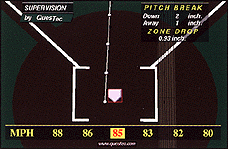
Overhead is the best perspective to see lateral movement of ball. System can show flight path of ball from any position.
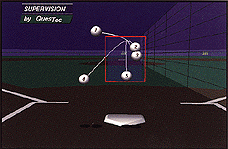
Recreating a pitch grouping to show what a pitcher threw to a particular batter in previous games.
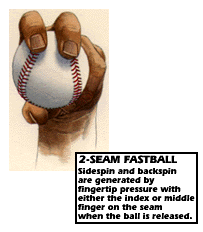
Sinking fastball
Looking at specific breaking pitches, the 2-seam fastball, also called a moving or sinking fastball, is gripped on top of the ball with the narrow seams exposed. This is in contrast to the 4-seam fastball, which must be gripped on the wide seams to get it to travel in a true trajectory with all seams rotating. Both of these fastball pitches are released with backspin.
When releasing this fastball, you usually apply pressure against the seam with either the index or middle finger. It's a matter of preference. This imparts the sidespin that causes the ball to drop. Lefthand pitchers like to use this pitch against lefthand hitters because the ball tends to break down and away.

Curveball
Years ago, this pitch was called a drop. I throw a curve with a 12 to 6 o'clock rotation. This release imparts sidespin and backspin because I maintain pressure on the ball with my middle finger while rolling it out over the top of my index finger. I like to throw the ball into the wind, because this increases the ball's rotation and helps the break. The key to the curveball is to keep your hand behind the ball as long as possible, impart the spin with the wrist and not with the elbow, and make sure the thumb is relaxed. I shorten my stride by 1 in. or so, compared to pitching a fastball. The object here is not to be throwing the ball toward the batter. You want a feeling like you're pulling down on the ball, almost like you're throwing it into the ground. This type of motion gives the ball the desired trajectory.
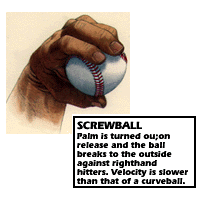
Screwball
The screwball is actually the opposite of the curveball, in terms of snapping the wrist. Whereas I grip and release the ball with my palm turned inward for a curve, I turn my palm out when throwing a screwball–almost like I'm turning a screwdriver.
The ball's trajectory is similar to a curve, but it can't be thrown quite as hard. So the velocity is less than that of the curveball. Also, the ball breaks outward, instead of inward like a curveball. Lefthand pitchers like to throw screwballs to righthand hitters because the ball starts toward the middle of the plate and then breaks away to the outside corner.

Forkball
The forkball, also known as a splitter or split-finger fastball, is an interesting pitch. You jam the ball between your first two fingers as hard as you can and deliver it with the same action as a fastball, with the wrist coming straight over from 12 to 6 o'clock. The ball travels with a lot of velocity, but with a tumbling kind of rotation. The rotation slows down as the ball approaches the plate, and if delivered correctly, the bottom kind of falls out of it.
The Mechanics of a Breaking Pitch. PopularMechanics.Com (2005). Retrieved December 4, 2005, from PopularMechanics.com: http://www.popularmechanics.com/science/sports/1283161.html